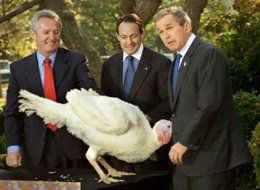
In 1621 the Plymouth colonists and the Wampanoag Indians stuffed their faces in an autumn harvest feast--the first Thanksgiving. Although Historians aren't certain of the menu, it's safe to say the pilgrims weren't gobbling up pesticide-smothered potatoes and antibiotic-infused turkey.
Fast forward nearly four centuries, and this Thursday the majority of American's will sit down to a copious table of factory-produced food. With few exceptions, 178 million plus turkeys will come from animal factories, while the vast majority of our fruits, vegetables; even vino will travel hundreds of miles from foreign farm factories. Such processing plants are reported to have few regulations and less regard for environmental best practice.
While raising turkeys in an industrial setting, or growing corn in a pesticide patch might make our food cheaper and available to a large number of consumers, factory farming comes with serious negative consequences for mother earth--clear cutting, dead zones, water wastage, methane-farting cattle, the list goes on. According to a 2006 study by the University of Chicago*, industrialized livestock produces more greenhouse gas emissions than global transportation.
Such studies come at a time when meat consumption, having quadrupled in the last 50 years, reaches an all-time high. The Worldwatch Institute claims global livestock population has increased 60 percent since 1961, and the number of for-food fowl has flown (try saying that ten times) from a stable 4.2 billion to blasphemous 15.7 billion.
Unlike the wild birds the Pilgrims ate, factory turkeys need antibiotics to stay alive, let alone healthy. Excuse me for being graphic, but the majority of factory-raised animals are reported to live so closely packed together that they have to defecate on each other. Such close-quarters create a cesspool of nasty, even deadly bacteria. I could go on and on.
Now, I'm not saying you should serve tofurkey this Thanksgiving. Although conventional meat production causes deforestation, polluted waterways and greenhouse gas blabidy-blah, I won't insist you replace the traditional Turkey with a slab of coagulated soybean cake--that would be gross and grossly hypocritical.
Perhaps hypocritical is an understatement considering I can barely go three weeks, perhaps even three days, without vivid fantasies of red meat bbq. Many lonely nights I have resembled the McDonald's Hamburgler, tip-toeing to the kitchen to gobble a few helpings of red-meat leftovers--ones I had so earnestly tried to refuse at dinner.
Confessions aside, there are a several environmental consequences to consider before we stuff-our-gobs this Thanksgiving day. And although I am not ready to hit up the tofurkey just yet, I sincerely hope to find a way/ask my mom to replace this years Franken-food feast with local and organic produce. In addition to spiking the apple cider, join me this Thanksgiving by following these three simple green food tips:
1. Go Local
As mentioned above, industrialization means our food is often processed in distant locations and must travel further to reach our refrigerators. Such distant travel contributes--massively--to greenhouse gas emissions. Rather than snacking on Australian Macadamia nuts, try to buy food that is local to your area. Or buy food from markets and stores that source from local farms. Whole Foods is a large supermarket chain that is very good at this.
If you prefer to avoid supermarkets, join a community supported agriculture program or CSA. CSAs are local farms, in which participants become "shareholders" and pledge a certain, fixed amount of financial support in the beginning of the growing season. Because CSA farms plant a large variety of crops, they are more sustainable than monoculture farms--crop rotation reduces the need for commercial fertilizers and pesticides. Find a list of CSAs in your area at localharvest.org.
2. Go Local Organic
Eating organic isn't just about putting pure food in our bodies; rather, organic promotes non-destructive agriculture and environmental best practice. As said above (I'm being repetitive, but trying to drill in my point) there are many problems--from disproportionate energy expenditure, to pesticide soil degradation, to groundwater contamination, to fertilizer flooded algal blooms--associated with conventional corporate farms. Eating organic ensures that you support food operations that take extra care to avoid such environmental harm.
I've found the Eat Well Guide, a free online directory of nearly 9,000 sustainable farms, markets, and restaurants, an excellent resource for those of us green to organic. Just enter your zip code--and voilà, you've got a personalized list of local organic options.
3. Go Local Organic . . . Turkey
As mentioned above meat has some scary environmental consequences. Choose your meat carefully and opt for the best you can afford. This year I'm pushing for some kind of certified organic, biodynamic, heritage turkey. I'm also going for a local bird. The majority of Turkeys are raised in Minnesota, North Carolina, Arkansas, Virginia, Missouri and California1. Does anyone know of any organic turkey farms in the New York metro area?
And one more for good measure . . . 4. Cross Disposables off Your List
Come on, it's a special occasion. Bring out the "good china," or at least the cloth napkins. Though big Thanksgiving feasts can translate into a lot of cleaning up, don't be tempted by plastic utensils those flimsy paper plates, napkins and tablecloths. Not only is it much more festive to use own stuff, but it also means that less waste ends up in the landfill--for the next 500 years! And really, do you think the Pilgrims and Wampanoag even had utensils? If they were lucky they got to chop into a slab of roasted eel with the communal carving knife. Other than that, they formed their fingers into little scoopers and got down to business without complaint.
*("Thanksgiving: Census Facts." Infoplease.
© 2000-2007 Pearson Education, publishing as Infoplease.
13 Nov. 2007.)